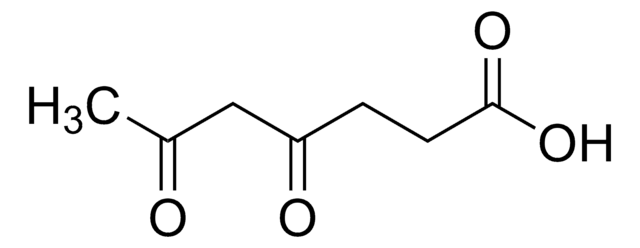The solubility of this material is not tested internally. While literature indicates that it is minimally soluble in water (around 4.6 g/L at 20°C), it should be more soluble in ethanol, methanol, diethyl ether, heptane, hexane, and carbon tetrachloride. Optimal concentration will need to be determined by the end user.
W254606
4-Heptanone
≥97%, FG
Sinonimo/i:
Butyrone, Dipropyl ketone
Scegli un formato
Scegli un formato
About This Item
Prodotti consigliati
Origine biologica
synthetic
Grado
FG
Fragrance grade
Halal
agenzia
follows IFRA guidelines
Conformità normativa
EU Regulation 1223/2009
EU Regulation 1334/2008 & 178/2002
FDA 21 CFR 117
FDA 21 CFR 172.515
Densità del vapore
3.93 (vs air)
Tensione di vapore
5.2 mmHg ( 20 °C)
Saggio
≥97%
Indice di rifrazione
n20/D 1.407 (lit.)
P. ebollizione
145 °C (lit.)
Punto di fusione
−33 °C (lit.)
Densità
0.817 g/mL at 25 °C (lit.)
applicazioni
flavors and fragrances
Documentazione
see Safety & Documentation for available documents
Allergene alimentare
no known allergens
Allergene in fragranze
no known allergens
Organolettico
cheese; fruity; pineapple; sweet
Stringa SMILE
CCCC(=O)CCC
InChI
1S/C7H14O/c1-3-5-7(8)6-4-2/h3-6H2,1-2H3
HCFAJYNVAYBARA-UHFFFAOYSA-N
Cerchi prodotti simili? Visita Guida al confronto tra prodotti
Categorie correlate
Azioni biochim/fisiol
Altre note
Avvertenze
Warning
Indicazioni di pericolo
Consigli di prudenza
Classi di pericolo
Acute Tox. 4 Inhalation - Flam. Liq. 3
Codice della classe di stoccaggio
3 - Flammable liquids
Classe di pericolosità dell'acqua (WGK)
WGK 2
Punto d’infiammabilità (°F)
120.2 °F - closed cup
Punto d’infiammabilità (°C)
49 °C - closed cup
Dispositivi di protezione individuale
Eyeshields, Faceshields, Gloves, type ABEK (EN14387) respirator filter
Scegli una delle versioni più recenti:
Possiedi già questo prodotto?
I documenti relativi ai prodotti acquistati recentemente sono disponibili nell’Archivio dei documenti.
-
Why 4-heptanone is insoluble?
1 answer-
Helpful?
-
Active Filters
Il team dei nostri ricercatori vanta grande esperienza in tutte le aree della ricerca quali Life Science, scienza dei materiali, sintesi chimica, cromatografia, discipline analitiche, ecc..
Contatta l'Assistenza Tecnica.









